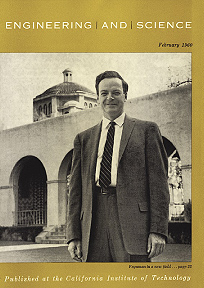
Fifty years ago today, on December 29, 1959, Richard P. Feynman gave an after-dinner talk in Pasadena at an annual post-Christmas meeting of the American Physical Society. Here is how Ed Regis describes the setting of the lecture in his rollicking book Nano:
In the banquet room [at the Huntington-Sheraton hotel in Pasadena], a giddy mood prevails. Feynman, although not yet the celebrity physicist he’d soon become, was already famous among his peers not only for having coinvented quantum electrodynamics, for which he’d later share the Nobel Prize, but also for his ribald wit, his clownishness, and his practical jokes. He was a regular good-time guy, and his announced topic for tonight was “There’s Plenty of Room at the Bottom” — whatever that meant.
“He had the world of young physicists absolutely terrorized because nobody knew what that title meant,” said physicist Donald Glaser. “Feynman didn’t tell anybody and refused to discuss it, but the young physicists looked at the title ‘There’s Plenty of Room at the Bottom’ and they thought it meant ‘There are plenty of lousy jobs in physics.’”
The actual subject of Feynman’s lecture was making things small and making small things.
What I want to talk about is the problem of manipulating and controlling things on a small scale.
As soon as I mention this, people tell me about miniaturization, and how far it has progressed today. They tell me about electric motors that are the size of the nail on your small finger. And there is a device on the market, they tell me, by which you can write the Lord’s Prayer on the head of a pin. But that’s nothing; that’s the most primitive, halting step in the direction I intend to discuss. It is a staggeringly small world that is below. In the year 2000, when they look back at this age, they will wonder why it was not until the year 1960 that anybody began seriously to move in this direction….
Feynman went on to imagine fitting the entire Encyclopaedia Britannica on the head of a pin, and even storing all the information in all the world’s books “in a cube of material one two-hundredth of an inch wide — which is the barest piece of dust that can be made out by the human eye.” He then described the miniaturization of computers, of medical machines, and more. He deferred on the question of how these things would technically be accomplished:
I will not now discuss how we are going to do it, but only what is possible in principle — in other words, what is possible according to the laws of physics. I am not inventing anti-gravity, which is possible someday only if the laws are not what we think. I am telling you what could be done if the laws are what we think; we are not doing it simply because we haven’t yet gotten around to it.
 And Feynman only barely touched on the question of why these things should be pursued — saying that it “surely would be fun” to do them. He closed by offering two thousand-dollar prizes. One would go to the first person to make a working electric motor that was no bigger than one sixty-fourth of an inch on any side; Feynman awarded that prize less than a year later. The other would go to the first person to shrink a page of text to 1/25,000 its size (the scale required for fitting Britannica on the head of a pin); Feynman awarded that in 1985.
And Feynman only barely touched on the question of why these things should be pursued — saying that it “surely would be fun” to do them. He closed by offering two thousand-dollar prizes. One would go to the first person to make a working electric motor that was no bigger than one sixty-fourth of an inch on any side; Feynman awarded that prize less than a year later. The other would go to the first person to shrink a page of text to 1/25,000 its size (the scale required for fitting Britannica on the head of a pin); Feynman awarded that in 1985.
Feynman’s lecture was published in Engineering and Science in 1960 — see the cover image at right — and it’s available in full online here. The lecture is often described as a major milestone in the history of nanotechnology, and is sometimes even credited with originating the idea of nanotechnology — even though he never used that word, even though others had anticipated him in some of the particulars, and even though the historical record shows that his talk was largely forgotten for about two decades. A few historians have sought to clarify the record, and none has done so more definitively than Christopher Toumey, a University of South Carolina cultural anthropologist. (See, for instance, Toumey’s short piece here, which links to two of his longer essays, or his recent Nature Nanotechnology piece here [subscription required].) Relying on journal citations and interviews with researchers, Toumey shows just how little direct influence Feynman’s lecture had, and compares Feynman’s case to that of Gregor Mendel: “No one denies that Mendel discovered the principles of genetics before anyone else, or that he published his findings in a scientific journal … but that ought not to be overinterpreted as directly inspiring or influencing the later geneticists” who rediscovered those principles on their own.
Toumey suggests that nanotechnology needed “an authoritative founding myth” and found it in Feynman. This is echoed by UC-Davis professor Colin Milburn in his 2008 book Nanovision. Milburn speaks of a “Feynman origin myth,” but then puts a slightly more cynical spin on it:
How better to ensure that your science is valid than to have one of the most famous physicists of all time pronouncing on the “possibility” of your field…. The argument is clearly not what Feynman said but that he said it.
Eric Drexler, whose ambitious vision of nanotechnology is certainly the one that has most captured the public imagination, has invoked the name of Feynman in nearly all of his major writings. This is not just a matter of acknowledging Feynman’s priority. As Drexler told Ed Regis, “It’s kind of useful to have a Richard Feynman to point to as someone who stated some of the core conclusions. You can say to skeptics, ‘Hey, argue with him!’”
How, then, should we remember Feynman’s talk? Fifty years later, it still remains too early to tell. The legacy of “Plenty of Room” will depend in large part on how nanotechnology — and specifically, Drexler’s vision of nanotechnology — pans out. If molecular manufacturing comes to fruition as Drexler describes it, Feynman will deserve credit for his imaginative prescience. If nothing ever comes of it — if Drexler’s vision isn’t pursued or is shown to be technically impossible — then Feynman’s lecture may well return to the quiet obscurity of its first two decades.
[UPDATE: Drexler himself offers some further thoughts on the anniversary of the Feynman lecture over on his blog Metamodern.]
